Prime Rib Cooking Time Medium Rare
Purchasing | Preparing Prime Rib | Prime Rib Marinades | Rubs for Prime Rib
Cooking Prime Rib | Checking Doneness | Carving Prime Rib | Serving Prime Rib
Knowing how to cook prime rib requires the understanding of only a few preparation steps and watching the temperature of the prime rib closely as it cooks. The information below will guide you through purchasing, preparing, and cooking prime rib.
Purchasing Prime Rib
Prime rib is actually the name used for a standing rib roast. It is very tender, flavorful, and expensive. It use to be that Prime Rib referred to a standing rib roast that was graded USDA Prime but these Prime graded roasts are now generally found mostly in restaurants because of their cost. The name Prime Rib is given to the standing rib roasts found in the supermarkets and are generally a USDA Choice grade. USDA grading is determined mostly according to the amount of marbling in the meat. See Beef Inspection and Grading for more information on the differences in the USDA grading.
| The USDA Choice graded prime rib will provide you with an excellent piece of meat. Select a prime rib roast that has a lot of marbling, which is the visible fat running throughout the meat. The more marbling there is in the meat the more moist and flavorful it will be when cooked. When considering the size of prime rib you will need, figure that each rib will feed two people. If serving 5 or 6 people, purchase a 3 rib roast. If serving 7 or 8 people, purchase a 4 rib roast. | 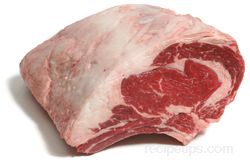 | |
| Another fact that is beneficial to know is that the prime rib consists of the seven ribs that are located from the shoulder down to the loin. The ribs closest to the shoulder are less tender than those located closest to the loin. The prime rib roast from the shoulder end is sometimes referred to as the large end rib roast or half standing rib roast. The prime rib roast from the loin end is sometimes referred to as the small end rib roast, sirloin tip roast, or the loin rib roast. | ||
Preparing Prime Rib
When cooking prime rib, it does not require a lot of preparation because you are working with a cut of meat that is delicious in itself. There are many different marinades and rubs that could be used but just salt and pepper is really enough. See the information below on how simple it is to prepare for cooking prime rib.
| Have the butcher or meat department cut off the chine bones from the bottom of the roast and the rib bones from the meat just along the bone line but do not discard them. They can be cut off in separate pieces or the chine bones can be cut off as one piece with the rib bones. | ||
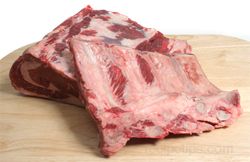 | Have the meat placed back on the rib bones and wrap them along with the chine bones to bring home to cook along with the meat. Having the bones cut away from the meat before cooking will make carving the finished prime rib a lot easier. | |
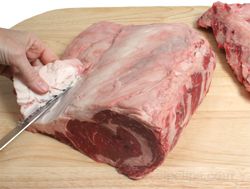 | At home, trim the fat anywhere it is over one inch thick. Do not trim to less than a quarter inch. The fat will help to add flavor and keep the meat moist. | |
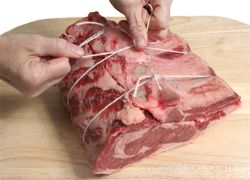 | Tie the meat to the rib bones and include the chine bones at the bottom of the prime rib roast. Tie around the meat and ribs in between the bones on each end, making sure to tie the chine bones to the meat also. Also tie around the meat and bones in the center of the prime rib. Tying the bones on the meat will provide the meat with the flavor from the bones and help keep the meat moist. | |
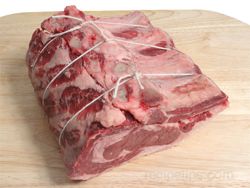 | Be sure to allow the prime rib to set out at room temperature for approximately two hours before cooking. Allow it to reach room temperature before cooking because the roast should not be cold when it starts to cook. | |
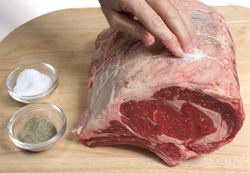 | When the meat has reached room temperature, rub the surface of the prime rib, meat and fat, with pepper and kosher salt. | |
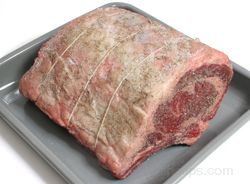 | Place the roast rib side down in a baking pan or roasting pan that has high sides. The pan does not need a rack to hold the roast because the bones act as a natural rack for the prime rib. The meat is now ready to be placed in the oven to cook. | |
Prime Rib Marinades
The prime rib does not have to be marinated to be delicious but some prefer using a marinade to enhance the flavor of the meat and some feel that it provides a moister and more tender meat. There are mixed opinions on whether the marinade makes the prime rib more tender. Using your own experience will be the best way to determine what you prefer. For more detailed information on using a marinade, see Grilling with Marinades and Rubs. This information relates to using marinades and rubs for any type of cooking, not only when grilling.
Provided below are a couple of simple marinade recipes that can be used with the prime rib but there are many other marinades that can be used.
| Orange Ginger Marinade | |||
| |||
| |
|
| |
| |||
| Red Wine Marinade | |||
| |||
| |
|
| |
| |||
Rubs for Prime Rib
Another method used to enhance the flavor is to use rubs for prime rib. Rubs consist of a mixture of seasonings and other ingredients that are rubbed into the surface of the meat. For more detailed information on using rubs for prime rib, see Grilling with Marinades and Rubs. This information relates to using marinades and rubs for any type of cooking, not only when grilling.
The recipes provided below are for several rubs that can be used when preparing prime rib. Mix the ingredients listed below and then rub into the entire surface of the prime rib. Rub into the meat and fat. Then allow the prime rib to set out until it is room temperature. No more than two hours before cooking.
| Simple Garlic Rub | |||
| |||
| |
|
| |
| Lemon Garlic Rub | |||
| |||
| |
|
| |
| Onion Prime Rib Rub | |||
| |||
| |
|
| |
Cooking Prime Rib
There are many different options on what temperature and how much time to use when cooking prime rib roast. The most important thing to keep in mind is that you do not want to overcook it. No matter what cooking temperatures and times you use, it is most important that you watch for doneness by checking it with a thermometer to be sure it is not getting too done. The information below provides you with one good method of cooking a prime rib.
| Preheat the oven to 450°F. Place the prime rib roast, prepared as shown above, on one of the lower racks of the preheated oven. |  | |
| After cooking for 15 minutes at 450°F, turn the oven down to 325°F. Do not open the oven. Cook at 325°F for approximately 11 to 13 minutes per pound. See the chart below for estimated cooking times. | ||
| 30 minutes before the end of the cooking time remove the prime rib roast from the oven and check the internal temperature. For the roast to be rare the internal temperature should be 120°F to 125°F but remove from the oven when it is 115°F to 120°F and allow to stand for 20 minutes. During this time the temperature will rise about another 5 to 10 degrees. | 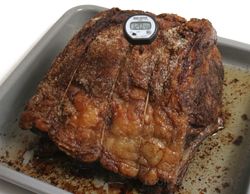 | |
| Note: The doneness temperatures stated above and below are traditional temperatures used for cooking prime rib but are not recommended by the USDA. See Beef Doneness for more information on beef cooking temperatures. | ||
| Remove from the oven and loosely tent aluminum foil over the prime rib and allow it to sit for at least 20 minutes. This will allow the juices to redistribute through the meat. After the prime rib has rested it will be ready to carve and serve. See Carving Prime Rib below. | 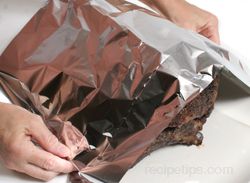 | |
| Estimated Cooking Times The cooking times below are approximate times only. Check doneness with a thermometer to be sure the prime rib is cooked properly. | ||
| No. of Ribs / Approximate Weight | Estimated Cooking Time/Temperature | |
| Rare | Medium Rare | |
| 3 Ribs | 1 1/4 to 1 1/2 hrs 120° - 125°F | 1 1/2 to 1 3/4 hrs 130° - 135°F |
| 4 Ribs 8.5 to 10 lbs. | 1 1/2 to 2 hrs 120° - 125°F | 1 3/4 to 2 1/4 hrs 130° - 135°F |
| 5 Ribs 10.5 to 13 lbs. | 2 to 2 1/2 hrs | 2 1/4 to 2 3/4 hrs 130° - 135°F |
| 6 Ribs 14 to 16 lbs. | 2 1/2 to 3 hrs 120° - 125°F | 3 to 3 1/2 hrs 130° - 135°F |
| 7 Ribs 16.5 to 18 lbs. | 3 to 3 1/2 hrs 120° - 125°F | 3 1/2 to 4 hrs 130° - 135°F |
Checking Doneness of the Prime Rib
| Watching for proper doneness is very important when cooking prime rib. The best manner in which to do this is to check the roast's temperature. A meat thermometer can be inserted in the prime rib before placing it in the oven but it may be hard to read the temperature closely at the end of cooking time. | ||
| An instant thermometer works very well because you can insert the thermometer towards the end of the cooking time and get an accurate reading in about 15 seconds. | 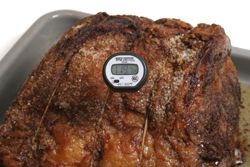 | |
| | ||
| Prime Rib Cooking Temperatures The chart below shows the temperatures of the different doneness levels of the prime rib and how it will look visually at those levels. | |
| Doneness / Temperature | Visual Doneness |
| Rare | The center is red with it turning pink towards the outer edge. |
| Medium-Rare 130° - 135°F | The center is dark pink with the meat beginning to turn light brown towards the outer edge. |
| Medium 140° - 145°F | The center is a light pink with more of the meat turning brown towards the outer edges. |
| Medium-Well 150° - 155°F | The center is light brown with the meat darkening towards the outer edges. |
| Well Done 160° & up | All the meat is evenly brown. |
Carving Prime Rib
If you had the chine bones and rib bones cut from the prime rib when you purchased it, carving is very simple. If you did not, the bones will need to be removed before carving. Remove the chine bones with one cut across the bottom of the roast. Then remove the rib bones by cutting parallel along the rib bones, cutting them away from the meat. Do not discard the bones. There is sure to be someone who will enjoy eating the delicious meat from these bones. The information below shows how easy it is to carve the prime rib if the bones were cut off by the butcher or meat department when it was purchased.
| | Place the prime rib roast on a cutting board and cut the strings that are holding the bones to the meat. | |
| | Remove the string and separate the bones from the meat and set aside. Keep the bones for someone who will enjoy eating the meat from the bones. | |
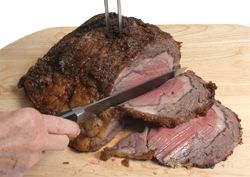 | Lay the prime rib roast on the cutting board with the rib bone side down. Cut slices across the grain of the roast to desired thickness. Slices are generally cut 1/4" to 1/2" thick. | |
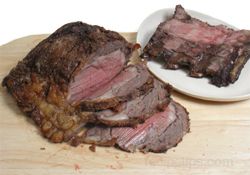 | Only cut the number of slices you will be serving from the roast. This will keep the leftover meat more moist for the next time it is served. |
Prime Rib Serving Suggestions
Prime rib is good served with most any side dishes you desire. A traditional side that is served with prime rib is Yorkshire pudding. This dish is made with some of the drippings from the roast so is a great accompaniment to the prime rib. A horseradish cream sauce is a popular condiment served with prime rib and of course, the Au Jus juice is most often drizzled over the meat when served. The recipes and preparation of these serving suggestions are shown below.
| Au Jus Juice The Au Jus is prepared from the drippings produced while the prime rib is cooking. Pour off the fat from the drippings and discard or set aside to be used for the Yorkshire pudding. If there are a lot of juices along with the fat, using a gravy separator works well to separate the fat from the juices. | 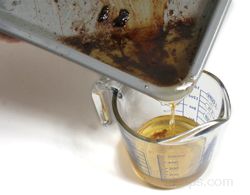 | |
| If there are juices from the drippings, pour the juices only back into the roasting pan. Discard all but 1/2 cup of the fat if making Yorkshire pudding. Add 1/2 cup of beef broth to the roasting pan and cook over medium heat. Stir and deglaze sides and bottom of the roasting pan to get all the browned pieces to add flavor to the juice. | 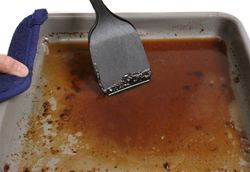 | |
| Bring the juices to a boil and cook until it is slightly reduced to intensify the flavor. Cook for approximately 2 minutes. Season the juice with salt and pepper to desired taste. | 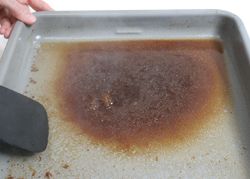 | |
| Pour Au Jus into a gravy bowl and drizzle over the prime rib when serving. | 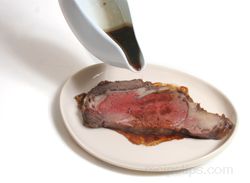 |
| Yorkshire Pudding | |||
| |||
| |
|
| |
| | Prepare the pudding while the prime rib is set aside resting. In a mixing bowl, combine all the ingredients except the pan drippings from the roast. Beat these ingredients with an electric mixer until smooth. | |
| | ||
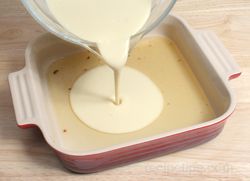 | Remove the baking pan from the oven and pour in the pudding batter but do not stir. Place back in the oven and turn oven temperature down to 350°F. | |
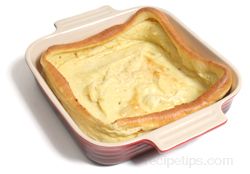 | Bake the pudding for approximately 30 minutes until it has puffed and turned golden brown. Carve the prime rib while the Yorkshire pudding is baking. When the pudding is done, cut into squares and serve with the prime rib. | |
| Creamy Horseradish Sauce | |||
| |||
| |
|
| |
| Mix up the horseradish sauce at least an hour before serving. It can be made up 1 or 2 days before hand and then refrigerated until ready to serve. | ||
| Place all the ingredients in a mixing bowl and stir by hand until thoroughly mixed. Note: A commercial horseradish sauce can be used in place of the prepared horseradish to provide a milder taste if desired. | 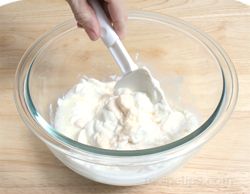 | |
| Pour into a small serving bowl and cover with plastic. Refrigerate for at least one hour. | 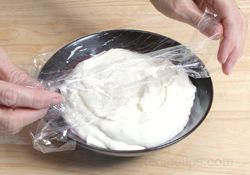 | |
These are just several serving suggestions. Gravy can also be made from the pan drippings and served with potatoes or drizzled over the meat. The prime rib will be delicious served with any of your favorite side dishes.
Prime Rib Cooking Time Medium Rare
Source: https://www.recipetips.com/kitchen-tips/t--1315/cooking-prime-rib.asp
Posted by: kleinsenjoyergoo.blogspot.com

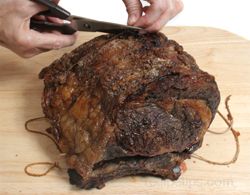
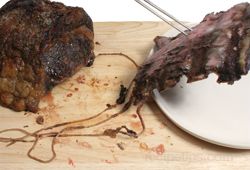
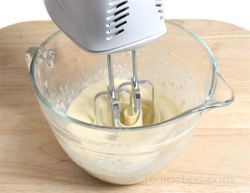
0 Response to "Prime Rib Cooking Time Medium Rare"
Post a Comment